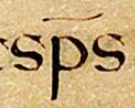Steven Avery
Administrator
Text
629 - 14th c - Ottobonianus diglot
61 - 16th c - Montfortianus
918 - 16th c - likely from Erasmus
2473 - 17th c
2318 - 18th c
110 - Ravianus, removed from Greek NT lists
margins
177 (10th c), margin 1785
636 (11th c),
88 (12th c) - Naples
429 (14th c)
221 (margin note put in 1800s)
==================
177 - Wallace

 vuntblog.blogspot.com
vuntblog.blogspot.com
==================
635 is typo
AirTable

======================
This post is only about the ms. 635 error, however, with the Elijah Hixson article and the Timothy Berg thread, and the Jeffrey Riddle response, we really have a fine starting point.
Those are the main discussion spots so far!
=======================
629 - 14th c - Ottobonianus diglot
61 - 16th c - Montfortianus
918 - 16th c - likely from Erasmus
2473 - 17th c
2318 - 18th c
110 - Ravianus, removed from Greek NT lists
margins
177 (10th c), margin 1785
636 (11th c),
88 (12th c) - Naples
429 (14th c)
221 (margin note put in 1800s)
==================
177 - Wallace
The Comma Johanneum in GA 177 (BSB Cod. Graec. 211)
Today, I found out that yet another New Testament Greek manuscript has gone online, min. 177 . It is found at the Digitale Bibliothek of the...
==================
635 is typo
AirTable
======================
This post is only about the ms. 635 error, however, with the Elijah Hixson article and the Timothy Berg thread, and the Jeffrey Riddle response, we really have a fine starting point.
Evangelical Textual Criticism
The Greek Manuscripts of the Comma Johanneum (1 John 5:7–8)
Elijah Hixson - January 7, 2019
https://evangelicaltextualcriticism.blogspot.com/2020/01/the-greek-manuscripts-of-comma.html
Timothy Berg wall - (fascinating discussion on many topics)
WM 149: Hixson, the CJ, and Roman Catholic Provenance
Jeffrey Riddle - January 18, 2020
http://www.jeffriddle.net/2020/01/wm-149-hixson-cj-and-roman-catholic.html
Facebook - PureBible
https://www.facebook.com/groups/purebible/permalink/2721156727976199/
Pure Bible Forum (this post)
https://www.purebibleforum.com/index.php?threads/the-greek-manuscripts-elijah-hixson.1301/#post-5235
1 John 5:7 and Modern Criticism
Taylor DeSoto - January 16, 2020
https://youngtextlessreformed.com/2020/01/16/1-john-57-and-modern-criticism/
First John 5:7 and Greek Manuscripts
James Snapp - January 19, 2020
http://www.thetextofthegospels.com/2020/01/first-john-57-and-greek-manuscripts.html
Those are the main discussion spots so far!
=======================
Evangelical Textual Criticism - post in queue (the on in queue has Rodrigo with the wrong spelling)
1/22/2019
Great post and discussion!
Over the years I have been making a major point on the accuracy of Greek ms. representation on the heavenly witnesses. My emphasis was often the Stephanus manuscript issue as well as placing the c. 10 extant mss in proper context.
So I really appreciate this blog post and possible future paper from Elijah Hixson, which can help clarify issues. . .
While I would like to add a few notes here, the most important in terms of the scholastic element follows:
=================
MS 635
Here is what Elijah says about ms 635:
=====================
Elijah Hixson
“... I want to mention that sometimes an eleventh Greek manuscript is cited. GA 635 is sometimes cited as having the CJ in the margin … I’m happy to update the post if someone has a better image or can make more sense of it. …
=====================
This “635mg” likely traces to a Bruce Metzger and UBS-1 error (likely a typo) and then Ian Howard Marshall had a note.
Metzger in 1968, the second edition, p. 101, did not include 635 or 636
http://www26.us.archive.org/stream/TheTextOfTheNewTestament2ndEdit#page/n101/mode/2up/search/comma
Metzger 1971, corrected 1975, p. 716-717 – definitely in 1975, apparently same p. in 1971
“and ms. 635, an eleventh century manuscript which has the passage written in the margin by a seventeenth century hand.”
http://www.bibletranslation.ws/trans/FirstJohnCh5v7.pdf




https://www.christianforums.com/threads/does-1-john-5-7-belong-in-the-bible.7766479/page-7
Metzger-Ehrman 2005 (updated, no error)
https://books.google.com/books?id=lA4WAwAAQBAJ&pg=PA147
======
The question is described here by Rodrigo Galiza in 2018
The Johannine Comma (1 John 5:7–8): The Status of Its Textual History and Theological Usage in English, Greek and Latin (2018)
Rodrigo Galiza and John W. Reeve
https://digitalcommons.andrews.edu/cgi/viewcontent.cgi?article=3617&context=auss
Please note that “635mg” was apparently a typographical error in Metzger’s first edition (635, without mg) that in his later work (idem, 2nd ed., 1994) is corrected to “636v.r.."
=======
Here we have the mention of UBS-1, which I have not confirmed.
Rick Henwood
“635mg XI cited by Metzger and UBS-1, but not N-A”
"The Attempts Throughout History to Corrupt and Counterfeit the Word of God”
=======
The Ian Howard Marshall text can be seen here:
(citing The Text of the New Testament, Metzger 1971, p. 717)
The Epistles of John (1978)
Ian Howard Marshall
https://books.google.com/books?id=gby-zhPba2AC&pg=PA236
“635mg -- so Metzger, 717; but UBS gives ... 636mg”
As pointed out by Galiza, Metzger was 635 not 635mg
=====
Clearly this section from Elijah Hixson on 635 should be “updated” to reflect the history. There is no need for a pic, or to talk about the text of the ms. And the blame for the errors in the books, Bruce Metzger followed by Ian Howard Marshall, and possibly UBS-1, can be assigned.
Note:
The paper from Rodrigo Galiza has an error about the 1582 Douay-Rheims and later simply the Douay-Rheims not having the verse. Four references total.
Steven Avery
Dutchess County
Last edited:



